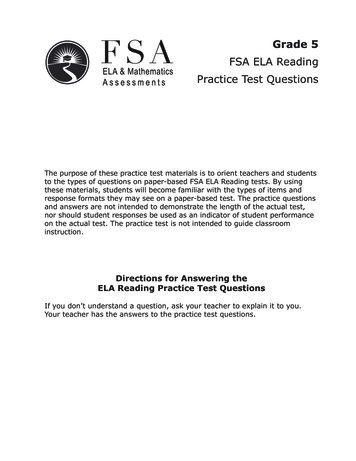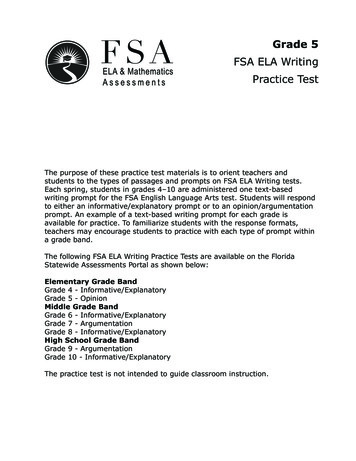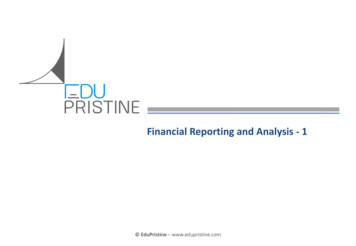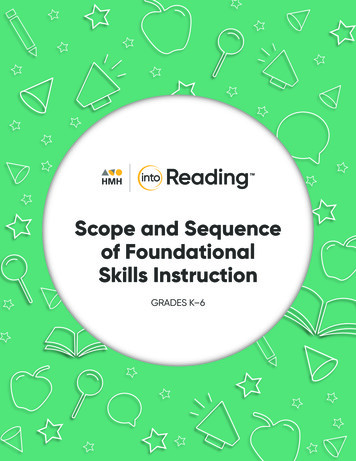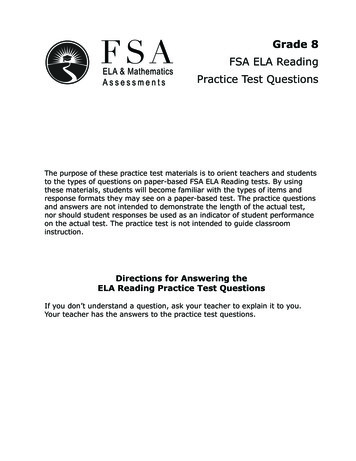
Transcription
Grade 8FSA ELA ReadingPractice Test QuestionsThe purpose of these practice test materials is to orient teachers and studentsto the types of questions on paper-based FSA ELA Reading tests. By usingthese materials, students will become familiar with the types of items andresponse formats they may see on a paper-based test. The practice questionsand answers are not intended to demonstrate the length of the actual test,nor should student responses be used as an indicator of student performanceon the actual test. The practice test is not intended to guide classroominstruction.Directions for Answering theELA Reading Practice Test QuestionsIf you don’t understand a question, ask your teacher to explain it to you.Your teacher has the answers to the practice test questions.
To offer students a variety of texts on the FSA ELA Reading tests, authenticand copyrighted stories, poems, and articles appear as they were originallypublished, as requested by the publisher and/or author. While thesereal-world examples do not always adhere to strict style conventions and/orgrammar rules, inconsistencies among passages should not detract fromstudents’ ability to understand and answer questions about the texts.All trademarks and trade names found in this publication are the propertyof their respective owners and are not associated with the publishers of thispublication.Every effort has been made to trace the ownership of all copyrightedmaterial and to secure the necessary permissions to reprint selections.Some items are reproduced with permission from Cambium Assessment,Inc., as copyright holder or under license from third parties.Page 2
BLANK PAGEPage 3
FSA ELA Reading Practice Test QuestionsRead the passages “from King Arthur’s Knights” and “Walcott Farm”and then answer Numbers 1 through 6.Passage 1: from King Arthur’s Knightsby Henry GilbertIn this excerpt from King Arthur’s Knights, the mythical King Arthur of Britainand his Knights of the Round Table receive a mysterious visitor at court. Thevisitor brings news about the quest for the Holy Grail, a powerful andmysterious artifact.1Then the door opened and an old and reverend man entered, whiteof beard and head, and clothed also in white; . . .2“Peace be with you, fair lords,” said the old man. Then turning tothe king he said:3“Sir, I bring here a young knight, the which is of king’s lineage,whereby the marvels of this court shall be accomplished, and the trialof this thy kingdom shall be brought to a happy end, if that may be.And the name of him is Galahad.”4“Sir,” said the king, “ye be right welcome and the young knightwith you.” . . .5Then was the young man led by the reverend man to the SiegePerilous,1 and sat him thereon, and men marvelled to see that thedeath-stroke did not flash like lightning and slay him.6“Sir,” said the old man to him, “wit ye well that that is your seat.For you are he that shall surely achieve the Holy Graal,2 and such ofthese your fellows as are pure in heart and humble shall achieve itwith you.”7“Sir,” said the king, “if it may be that ye know, will ye tell us whatmy knights must do to achieve the Holy Vessel, and thus bring peaceinto my kingdom in place of war? For many of those that are kings andbarons under me are warring with each other, and threaten to rend thisisland of Britain, . . . And it goeth to my heart to know this, and I havemuch dread.”1Siege Perilous: mystical chair that would slay any but the greatest knight who triedto sit in it2Graal: alternate spelling of Grail, as in Holy GrailPage 4Go On
FSA ELA Reading Practice Test Questions8“Sir king,” said the old white man, “none may tell you what shall bethe end of this quest of the Holy Graal, . . . ye war with each other, andare evil livers and full of pride and mastery, and if ye do not repent andstay your dishonour, then shall the Holy Vessel pass from Britain, andruin and death and civil war shall stalk through the land and leave itdesolate.” . . .9Then uprose Sir Gawaine, who was a faithful knight and true manto his king, though a proud one and a hasty. He was filled with sorrowfor the ruin that threatened his fair land.10“Now I do here avow,” he said, “that to-morrow, without fail, I shallset forth, and I shall labour with all the strength of my body and mysoul to go in quest of the Holy Graal, so that if I be fit to see it and tobring it hither, this dear land may be saved from woe.”11So hot were his words that many of the better knights rose also,and raising their right hands did make a like avowal; . . .Excerpt from King Arthur’s Knights by Henry Gilbert. In the public domain.Passage 2: Walcott Farmby Ryan Effgen12Graham sat at the kitchen table and sweated over the pile of cropreports and bank statements. Outside, rain plummeted down on thefarm, as if to mock him. After the long drought, this August rain woulddo him no good. His sons disagreed about how to save the farm, andarguments had led to threats of lawsuits. Graham remaineddetermined; the farm had been established by an ancestor who wasone of Paul Revere’s Minutemen—or so the story went—and the mainhouse, built of cobblestone, had the original potbellied stove and otherarchaic features.13Bleary-eyed and exhausted, Graham continued to look for a decimalpoint in the wrong place, but the numbers always came up the same.He heard a loud banging at the door, as if the storm itself was trying toforce its way in. Probably the rusty latch failing him now, too. He gotup to tighten the lock, but as he fiddled with the chain, the bangingincreased. Graham cracked the door open, and it spun back on itshinges in the storm’s wind. An old man, rain-drenched and wild-eyed,stood on the doorstep.Page 5Go On
FSA ELA Reading Practice Test Questions14He said, “We never used to keep that door locked, not even whentimes were hard and folks took to robbing one another.”15The man shouldered past Graham into the kitchen. He lookedaround the room, and as his eyes met various objects, he seemed toacknowledge them. Graham had no idea who this person was, but hefelt he ought to deal gently with him; the man was clearly confused.16“How can I help you, sir?” Graham asked. “I think you’ve ended upat the wrong house.”17The man seemed to think this was funny. “I know exactly where Iam: the legendary Walcott Farm. This farm’s been up and running eversince this nation became a nation. And you, if I’m not wrong, areGraham Walcott.”18This gave Graham pause. The man’s familiarity annoyed him, butGraham still felt it best to deal with him carefully. “And you are?”19“I’m Caleb Walcott, your father’s brother, and I grew up in thishouse. I’m the one who ran off to find his fortune out West. Wish Icould say it panned out, but it didn’t. Luckily for me—for the both ofus, looks like—the real fortune is right here, beneath our feet.”20Graham’s father had never mentioned having a brother; this man’sstory was preposterous. A bolt of lightning cracked outside, and with itcame a flash of inspiration. Graham returned to his seat and gesturedto a large, carved oak chair that stood against the center wall. “Well,Caleb, why don’t you pull that chair up to the table and you can tell meabout this fortune that we’re both standing on?”21The old man smiled. “I can’t blame you for testing me, but we bothknow that chair’s chiseled from a tree trunk rooted forty feet into theearth. A twister could carry off this house and that chair would still bestanding upright in that exact place.”22Graham stood. “Nobody outside of this family knows about thatchair.”23The man added, “And even fewer know what I’m about to tell you.My grandfather told me this story, and only once. When the founder ofthis farm came over from England, he brought with him some pricelessobject, something royal, maybe a scepter or a crown. Whether heburied it from thieves or tax collectors, I don’t know. Either way,somewhere out there,” the man gestured grandly towards the farmoutside the window, “is a treasure.”Page 6Go On
FSA ELA Reading Practice Test Questions24Outside, lightning cracked again and a ripple of thunder shook thewindows. The logical explanation was that the man was delusional, orperhaps he was a thief and this was the start of some elaborate scam.But the man knew about the chair—nobody knew about the chair.Graham paced, wondering if he was imagining it all—if, at the end ofhis rope, his mind had conjured up a fantastic story as a way ofavoiding the plain truth: the family farm was done for. Graham satdown in the large oaken chair. He ran his hands along the armreststhat had been carved by his ancestors hundreds of years before. Was itimpossible that some priceless relic was out there buried in his land?What did he lose by giving the idea a chance?25Graham turned to the old man and asked, “How are we going tofind it?”“Walcott Farm” by Ryan Effgen. Written for educational purposes.1015Page 7Go On
FSA ELA Reading Practice Test QuestionsNow answer Numbers 1 through 6. Base your answers on thepassages “from King Arthur’s Knights” and “Walcott Farm.”1. Fill in the bubbles before two details from Passage 1 that show whyGawaine chooses to pursue the Graal.9A Then uprose Sir Gawaine, B who was a faithful knight and trueman to his king, C though a proud one and a hasty. D He was filledwith sorrow for the ruin that threatened his fair land.E “Now I do here avow,” he said, F “that to-morrow, without fail,I shall set forth, G and I shall labour with all the strength of my bodyand my soul H to go in quest of the Holy Graal, I so that if I be fit tosee it and to bring it hither, J this dear land may be saved from woe.”10K So hot were his words L that many of the better knights rosealso, M and raising their right hands did make a like avowal; . . .1114623Page 8Go On
FSA ELA Reading Practice Test Questions2. This question has two parts. First, answer Part A. Then, answer Part B.Part AIn Passage 2, what theme is suggested by Graham’s situation?A First instincts are usually correct.B A sense of adventure can solve many problems.C Planning ahead can help one understand a situation more clearly.D People will do whatever is necessary to keep what is importantto them.Part BWhich quotation helps develop the theme in Part A?A “‘Luckily for me—for the both of us, looks like—the real fortune isright here, beneath our feet.’” (paragraph 19)B “Graham’s father had never mentioned having a brother; this man’sstory was preposterous.” (paragraph 20)C “‘Either way, somewhere out there,’ the man gestured grandlytowards the farm outside the window, ‘is a treasure.’” (paragraph 23)D “Graham turned to the old man and asked, ‘How are we going to findit?’” (paragraph 25)15055Page 9Go On
FSA ELA Reading Practice Test Questions3. Read the excerpt from Passage 1.3“Sir, I bring here a young knight, the which is of king’s lineage,whereby the marvels of this court shall be accomplished, and the trialof this thy kingdom shall be brought to a happy end, if that may be.And the name of him is Galahad.”What does the use of the word “trial” suggest in this excerpt?A The kingdom is under pressure from enemy countries.B The kingdom has endured many hardships in the past.C The old man will judge those who fail to obtain the Graal.D The knights have a legal responsibility to pursue the Graal.14626Page 10Go On
FSA ELA Reading Practice Test Questions4. This question has two parts. First, answer Part A. Then, answer Part B.Part AHow is the structure of Passage 2 different from the structure ofPassage 1?A Passage 2 ends by foreshadowing what will happen next.B Passage 2 builds toward a climax as the story progresses.C Passage 2 describes the characters’ thoughts and actions in betweendialogue.D Passage 2 introduces the main character’s conflict before anythingelse occurs.Part BWhich aspect of the passages is affected by this difference in structure?A how the reader imagines the stories will endB the way the characters’ goals are revealedC the number of ways the stories can be understoodD how the reader knows what the main characters are thinking15057Page 11Go On
FSA ELA Reading Practice Test Questions5. Read this excerpt from Passage 1.7“Sir,” said the king, “if it may be that ye know, will ye tell us whatmy knights must do to achieve the Holy Vessel, and thus bring peaceinto my kingdom in place of war? For many of those that are kings andbarons under me are warring with each other, and threaten to rend thisisland of Britain, . . . And it goeth to my heart to know this, and I havemuch dread.”8“Sir king,” said the old white man, “none may tell you what shall bethe end of this quest of the Holy Graal, . . . ye war with each other, andare evil livers and full of pride and mastery, and if ye do not repent andstay your dishonour, then shall the Holy Vessel pass from Britain, andruin and death and civil war shall stalk through the land and leave itdesolate.”How does the speaker’s point of view in this excerpt increase the tensionof Passage 1?A by showing that the power of the Graal has the potential to do harmB by showing that the Graal has likely been lost to the kingdom foreverC by showing that Britain is less powerful than the knights believe itto beD by showing that the knights share responsibility for the conditionof Britain14629Page 12Go On
FSA ELA Reading Practice Test Questions6. Select two ways that the story in Passage 2 is similar to the story inPassage 1.A Both stories feature characters who share a common goal.B Both stories include dialogue between characters with conflictingviews.C Both stories feature central characters who change their point ofview in the end.D Both stories describe the details of the setting to create a mysteriousatmosphere.E Both stories present a challenge and a way for the central characterto overcome it.15058Page 13Go On
FSA ELA Reading Practice Test QuestionsListen to the audio clip “Environment Matters Podcast,” read thepassages “Compact Fluorescent Lamps (CFLs)—Fact Sheet/FAQ” and“Lifetime Savings,” and then answer Numbers 7 through 15.Passage 1 Audio Clip: EnvironmentMatters PodcastRaise your hand so your test administrator can provide youaccess to this audio passage.Listen to the following podcast about compact fluorescent light bulbs.“Environment Matters Podcast” from the U.S. Environmental Protection Agency. In the public domain.The clip begins at 0:51 and ends at 2:20.Passage 2: Compact Fluorescent Lamps(CFLs)—Fact Sheet/FAQby the U.S. Food and Drug AdministrationWhat are compact fluorescent lamps (CFLs)?1CFLs are a type of fluorescent lamp. Many models of CFLs areavailable that are designed to replace traditional incandescent bulbs.The compact size of these CFLs allows them to fit into many existingincandescent light fixtures, including table and floor lamps commonlyfound in households. CFLs are very energy efficient, usingapproximately one quarter of the energy compared to traditionalincandescent bulbs. CFLs also have a very long lifespan, typically6000–15,000 hours compared to the 750–1,000 hours for a normalincandescent bulb.Do CFLs emit UV?12All fluorescent lamps emit some UV. Typical fluorescent lamps,including CFLs, which consumers would encounter, emit very low levelsof UV. In order to measure any UV radiation from these lamps, verysensitive measuring equipment must be used.1UV: ultraviolet radiation, a form of energy found in sunlight and some types oflamps. UV can affect the health of humans in either positive or negative ways,depending on the type and the amount of exposure to it.Page 14Go On
FSA ELA Reading Practice Test QuestionsHow do I know that the level of UV is acceptably low froma CFL?3The Illuminating Engineering Society of North America (IESNA) haspublished a series of standards relating to radiation emissions fromgeneral purpose lighting. If a CFL were to exceed allowable levels of UV(according to IESNA RP 27.3), its packaging would be required to belabeled with a caution label. This standard, which was developed withthe assistance of the FDA, requires lamp manufacturers to provide asuitable caution if one is needed. At typical use distances, UV levelsfrom CFLs fall below the level of general concern for normal, healthyindividuals and therefore carry no such warning.How close can we safely get to an operating CFL?4Unless you are one of the few individuals who have a medicalcondition (such as some forms of lupus) that makes you particularlysensitive to either UV or even visible light, you should be able to usethese lamps at the same distance as you would use traditionalincandescent lamps. However, a recent study from the United KingdomHealth Protection Agency has found that there are measurable levelsof UV from single envelope CFLs when used at distances closer than1 foot. As a precaution, it is recommended that these types ofCFLs not be used at distances closer than 1 foot, for more thanone hour per day.Are there precautions I can take to reduce the small levels ofUV from CFLs still further if I should wish to do so?5The glass used in CFLs already provides a UV filtering effect. Inaddition, any additional glass, or plastic, or fabric used in lightingfixtures that is between you and the CFL will further reduce the alreadylow levels to still lower levels since these materials act as additional UVfilters. Increasing the distance between you and any radiation source,including CFLs, will also reduce the small level to a lower level.6However, if you still wish to take additional steps then you mightwish to purchase the type of CFL that has an additional glass or plasticcover that encloses the CFL to make it appear more like a traditionalincandescent lamp. These covers provide an additional reduction of thelow level of UV to a lower level.Page 15Go On
FSA ELA Reading Practice Test QuestionsAny other safety concerns? I have heard CFLs contain mercury.2Should I be concerned?7Like traditional tube-style fluorescent lamps, CFLs contain a smallamount of mercury. It is the use of this small amount of mercury thatallows any fluorescent lamp to produce visible illumination at muchhigher efficiency levels than incandescent lighting. Typical householdCFLs contain less than 5 mg of mercury, which is a sphere about thesize of the tip of a pen. CFLs do not emit mercury as they operate. Theonly way mercury could be emitted from a CFL would be if the outerglass tubing that contains the mercury were to break.8Care should be taken not to break a CFL. If you break one, youshould carefully clean up the entire residue according to EPAinstructions that you can find at http://www.epa.gov/mercury/spills/index.htm.What about other potential adverse health effects from CFLs?I have seen some claims that CFLs cause headaches in somepeople. Is this true?9The vast majority of CFL users, both in households and incommercial buildings, report no issues regarding CFL usage, includingheadaches. There are some anecdotal reports, however, and, althoughthere is yet no research to directly explain any plausible causativemechanism, it may be possible that some people are susceptible tosuch headache effects just as some people claim to be annoyed bynormal fluorescent lighting. However, the overwhelming numbers ofpeople that use CFLs report no such negative effects. FDA expects thatresearch in this area will continue, and, as any new informationdevelops, it will be included in an updated FAQ.2mercury: a metallic element that exists as a liquid at normal temperatures.Often used in thermometers, mercury can be poisonous to humans under certainconditions.Excerpt from “Compact Fluorescent Lamps (CFLs)—Fact Sheet/FAQ” by the U.S. Food andDrug Administration. In the public domain.Page 16Go On
FSA ELA Reading Practice Test QuestionsPassage 3: Lifetime Savings“Lifetime Savings” from the U.S. Environmental Protection Agency, Energy Star program. In thepublic domain.979Page 17Go On
FSA ELA Reading Practice Test QuestionsNow answer Numbers 7 through 15. Base your answers on the audioclip “Environment Matters Podcast” and the passages “CompactFluorescent Lamps (CFLs)—Fact Sheet/FAQ” and “Lifetime Savings.”7. Fill in the bubbles before two sentences from paragraph 1 of Passage 2that suggest it would be easy for consumers to start using CFLs.1A CFLs are a type of fluorescent lamp. B Many models of CFLs areavailable that are designed to replace traditional incandescent bulbs.C The compact size of these CFLs allows them to fit into many existingincandescent light fixtures, including table and floor lamps commonlyfound in households. D CFLs are very energy efficient, usingapproximately one quarter of the energy compared to traditionalincandescent bulbs. E CFLs also have a very long lifespan, typically6000–15,000 hours compared to the 750–1,000 hours for a normalincandescent bulb.14827Page 18Go On
FSA ELA Reading Practice Test Questions8. This question has two parts. First, answer Part A. Then, answer Part B.Part AWhat is the central idea of Passage 2?A CFLs offer an inexpensive, more practical choice for consumers.B CFLs have many advantages over traditional light bulbs.C CFLs are a new, more efficient type of light bulb.D CFLs are very safe for people to use.Part BHow is the central idea developed throughout Passage 2?A by comparing and contrasting CFLs with traditional bulbsB by detailing the way in which CFLs generate lightC by responding to reported concerns about CFLsD by listing the various benefits of using CFLs14761Page 19Go On
FSA ELA Reading Practice Test Questions9. How does the diagram in Passage 3 distinguish between the differenttypes of light bulbs?A by showing the replacement costs associated with each type oflight bulbB by showing the overall energy costs associated with each type oflight bulbC by showing the amount of energy generated by each type of lightbulb per hour of useD by showing the amount of waste generated by each type of light bulbwhen each is recycled14764Page 20Go On
FSA ELA Reading Practice Test Questions10. This question has two parts. First, answer Part A. Then, answer Part B.Part AWhat is the tone of paragraph 7 in Passage 2?A dismissiveB reassuringC upliftingD fearfulPart BFill in the bubble before the sentence from paragraph 7 that mostclearly contributes to this tone.7A Like traditional tube-style fluorescent lamps, CFLs contain asmall amount of mercury. B It is the use of this small amount ofmercury that allows any fluorescent lamp to produce visibleillumination at much higher efficiency levels than incandescent lighting.C Typical household CFLs contain less than 5 mg of mercury, which isa sphere about the size of the tip of a pen. D CFLs do not emitmercury as they operate. E The only way mercury could be emittedfrom a CFL would be if the outer glass tubing that contains the mercurywere to break.14804Page 21Go On
FSA ELA Reading Practice Test Questions11. This question has two parts. First, answer Part A. Then, answer Part B.Part AFill in the bubble before the sentence from paragraph 5 of Passage 2that offers general safety advice about exposure to UV.A The glass used in CFLs already provides a UV filtering effect.5B In addition, any additional glass, or plastic, or fabric used in lightingfixtures that is between you and the CFL will further reduce the alreadylow levels to still lower levels since these materials act as additional UVfilters. C Increasing the distance between you and any radiationsource, including CFLs, will also reduce the small level to a lower level.Part BWhat key idea from Passage 2 does the sentence chosen in Part Asupport?A CFLs fail to adequately filter exposure to UV.B There are additional ways to lessen exposure to UV.C CFLs expose people to less UV than other types of bulbs.D There are many lighting fixtures that block exposure to UV.14805Page 22Go On
FSA ELA Reading Practice Test Questions12. This question has two parts. First, answer Part A. Then, answer Part B.Part AWhat is the interviewer’s purpose in Passage 1?A to find solutions to the dangers posed by CFLsB to explore the costs and benefits of using CFLsC to question consumers about their opinion of CFLsD to promote the use of CFLs over incandescent bulbsPart BHow does the interviewer achieve her purpose in Passage 1?A by asking questions of people who support and people who opposeCFL useB by asking questions that emphasize advantages of and minimizeconcerns about CFLsC by limiting the questions to those addressing health and safetyconcerns related to CFLsD by limiting the questions to those addressing consumermisunderstandings about switching to CFLs14809Page 23Go On
FSA ELA Reading Practice Test Questions13. Select two advantages of using audio in Passage 1 to presentinformation about CFLs.A It allows listeners to connect with other people as they sharereal-world experiences with CFLs.B It allows listeners to rely on tone of voice in order to betterunderstand each speaker’s point of view about CFLs.C It allows listeners to interpret the conversational nature of thepodcast in a way that makes CFLs seem less threatening.D It allows listeners to easily distinguish between viewpoints aboutCFLs by associating each viewpoint with a different speaker.E It allows listeners to be swayed by the emotional and personalappeals each speaker makes about CFLs throughout the podcast.1481414. The podcast guest in Passage 1 makes several claims about CFLs.Which claim is offered without sufficient supporting evidence?A CFLs provide significant energy savings compared toincandescent bulbs.B Using CFLs is better for the environment than usingincandescent bulbs.C The small amount of mercury in CFLs presents little riskto consumers.D CFLs are easy to dispose of when they eventually burn out.14810Page 24Go On
FSA ELA Reading Practice Test Questions15. Fill in the bubbles to match the claims made by the speaker in Passage 1with the supporting evidence provided for each claim.Claim: CFLsbenefit boththe environmentand the economy.Claim: Theenvironmentaldisadvantages ofCFLs can beovercome.CFLs use 75% lessenergy than traditionallight bulbs.ABThe amount of mercuryin a CFL is equivalent tothe tip of a ballpoint pen.CDThe energy savingsfrom CFLs could power3 million homes fora year.EF15201Page 25Go On
FSA ELA Reading Practice Test QuestionsRead the passage and then answer Numbers 16 through 18. Thereare four underlined words or phrases in the passage to show whichword or phrase may be incorrect.Julia gazed out on the blue—nothing but blue for days. “Blue is better thanstorms,” the ship’s captain warned her. She remembered looking at the big,blue space on the map indecating the Pacific Ocean. That preview had notprepared her. This trip was showing her the true size of the Pacific.Julia and her parents were headed for Palmerston Island, due west of Tahiti.Palmerston is part of the Cook Islands, has 62 residents, and is one of themost isolated inhabited places on the planet. The only way to get there is byboat, even in the twenty-first century.Her parents were anthropologists. Study various cultures throughout theworld was their mission. Every few years, the family moved for one of their“great adventures.” The only regularly scheduled ship visited Palmerstontwice a year to pick up fish and drop off supplies. Her family will be stuckthere for at least six months, and her parents planned to make it a year.Page 26Go On
FSA ELA Reading Practice Test QuestionsNow answer Numbers 16 through 18. Choose the correct word orphrase for each of the following.16. She remembered looking at thebig, blue space on the mapindecating the Pacific Ocean.A indicating18. Part AStudy various culturesthroughout the world was theirmission.B endacatingA StudiesC endicatingB StudyingD correct as is14871C StudiedD correct as isPart B17. The only way to get there is byboat, even in the twenty-firstcentury.C is toB boat; evenD correct as isC boat: evenPage 27A wouldB is going toA boat evenD correct as isHer family will be stuck therefor at least six months, andher parents planned to make ita year.1487214871Go On
FSA ELA Reading Practice Test QuestionsRead this passage and then answer the questions on the followingpage. Each underlined section is part of a question.192021When one thinks of ancient Egyptian queens, Cleopatra is probably thename that comes to mind. However, female rulers were surprisinglycommon in ancient Egypt, and some of the most influenchial royals inEgyptian history were women. Compared to women in other ancientcultures, Egyptian women had more rights: they could own land, choosetheir own husbands, and participate in government.One of the first known female rulers, MerNeith, ruled Egypt until herinfant son was old enough to take the throne. Despite being a sortof “placeholder,” ancient artifacts show that MerNeith governed thekingdom and likely passed laws during this time. Nefertiti is one ofthe most famous Egyptian queens. She ruled during Egypt’s mostprosperous time and was responsible for reshaping the culture’sreligious beliefs. Although she ruled alongside her husband, she isdepicted far more often than he is in sculptures and artwork, suggestingthat the people considered her the more important ruler.Though she’s not as famous as others, Hatshepsut was one of the mostimportant Egyptian queens in history. The full title and powers of apharoah were assumed by her. She often went so far as dressing as aman and having her subjects refer to her as “King” to ensure respect.Hatshepsut ruled for more than 20 years and left the kingdom in farbetter condition politically and economically than when she first tookpower. She also prepared her stepson to rule after her, and he expandedEgypt’s empire to its largest size.1070Page 28Go On
FSA ELA Reading Practice Test QuestionsNow answer Numbers 19 through 21.19. Choose the correct spelling.21. Choose the appropriate sentenceto be used in the passage.A influencialA She the full title and powersB influenshialof a pharoah
Grade 8 FSA ELA Reading Practice Test Questions Directions for Answering the ELA Reading Practice Test Questions If you don’t understand a question, ask your teacher to explain it to you. Your teacher has the answers to the practice test questions. The purpose of these p
